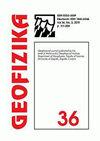Kratkoročna prognoza vidljivosti određena metodom slučajne šume
IF 1.1
4区 地球科学
Q4 GEOCHEMISTRY & GEOPHYSICS
引用次数: 0
Abstract
Accurate visibility forecasting is essential for safe aircraft operations. This study examines how various configurations of the Random Forest model can enhance visibility predictions. Preprocessing techniques are employed, including correlation analysis to identify fundamental relationships in weather observations. Time-series data is transformed into a regular Data Frame to facilitate analysis. This study proposes a classification framework for organizing visibility data and phenomena, which is then used to develop a visibility forecast using the Random Forest method. The study also presents procedures for hyperparameter tuning, feature selection, data balancing, and accuracy evaluation for this dataset. The main outcomes are the Random Forest model parameters for a three-hour visibility forecast, along with an analysis of errors in low visibility forecasts. Additionally, models for one-hour forecasts and visibility forecasting under precipitation are also examined. The resulting models demonstrate a deterministic forecast accuracy of approximately 78%, with a false alarm rate of around 6%, providing a comprehensive overview of the capabilities of the Random Forest model for visibility forecasting. As anticipated, the model demonstrated limitations in accurately simulating fast radiative cooling or abrupt decreases in visibility caused by precipitation. Specifically, in relation to precipitation, the model achieved an accuracy of 79%, yet exhibited a false alarm rate of 19%. Additionally, this method sets a foundation for enhancing prediction accuracy through the inclusion of supplementary forecast data, while its implementation on real-world datasets expands the reach of machine learning techniques to the members of the meteorological community.短期视觉预报是用偶然森林法确定的
准确的能见度预报对飞机的安全运行至关重要。本研究考察了随机森林模型的各种配置如何增强可见性预测。采用了包括相关分析在内的预处理技术,以确定天气观测的基本关系。将时间序列数据转换为规则的数据框架,以方便分析。本研究提出了一个分类框架,用于组织能见度数据和现象,然后使用随机森林方法开发能见度预测。该研究还提出了该数据集的超参数调优、特征选择、数据平衡和准确性评估的程序。主要结果是三小时能见度预报的随机森林模型参数,以及低能见度预报的误差分析。此外,还研究了降水条件下的一小时预报模式和能见度预报模式。结果表明,模型的确定性预测精度约为78%,误报率约为6%,提供了随机森林模型在能见度预测方面的全面概述。正如预期的那样,该模式在准确模拟由降水引起的快速辐射冷却或能见度突然下降方面显示出局限性。具体来说,在降水方面,该模型达到了79%的准确率,但显示出19%的误报率。此外,该方法通过包含补充预报数据为提高预测精度奠定了基础,而它在真实数据集上的实施将机器学习技术的范围扩展到气象界的成员。
本文章由计算机程序翻译,如有差异,请以英文原文为准。
求助全文
约1分钟内获得全文
求助全文
来源期刊

Geofizika
地学-地球化学与地球物理
CiteScore
1.60
自引率
0.00%
发文量
17
审稿时长
>12 weeks
期刊介绍:
The Geofizika journal succeeds the Papers series (Radovi), which has been published since 1923 at the Geophysical Institute in Zagreb (current the Department of Geophysics, Faculty of Science, University of Zagreb).
Geofizika publishes contributions dealing with physics of the atmosphere, the sea and the Earth''s interior.
 求助内容:
求助内容: 应助结果提醒方式:
应助结果提醒方式:


